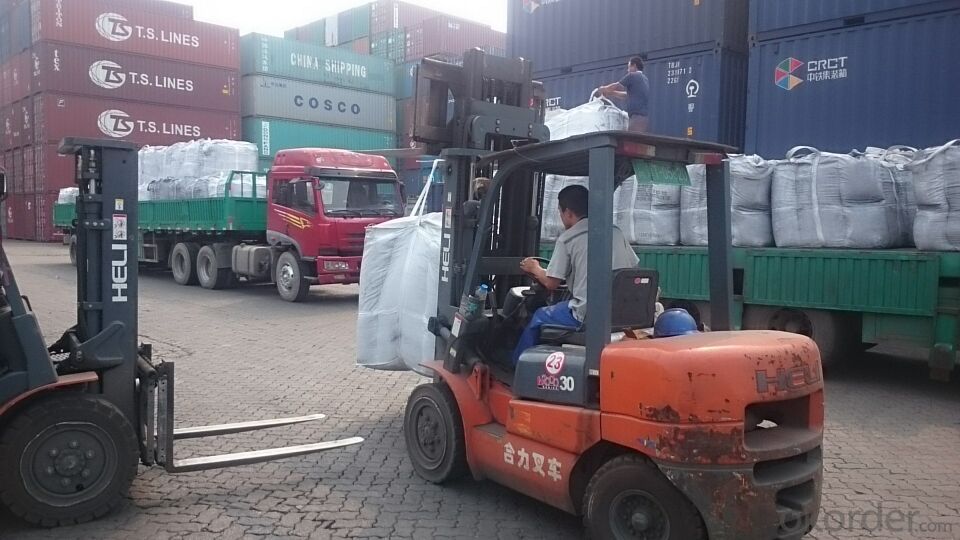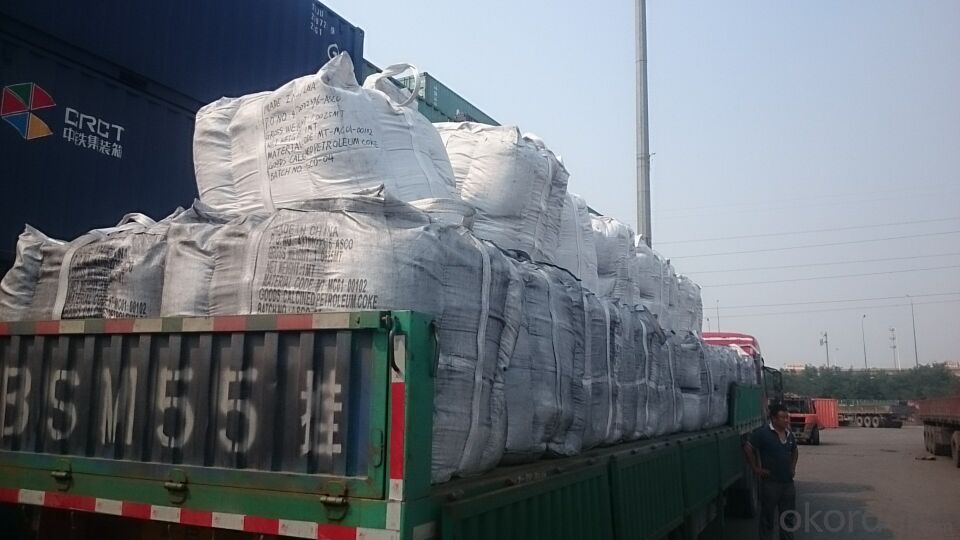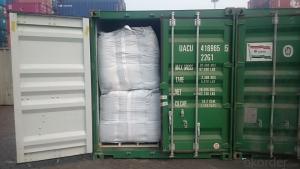GPC with lower Sulphur0.03% max in steady quality
- Loading Port:
- Tianjin
- Payment Terms:
- TT OR LC
- Min Order Qty:
- 21 m.t.
- Supply Capability:
- 5000 m.t./month
OKorder Service Pledge
OKorder Financial Service
You Might Also Like
Introduction:
GPC has good characteristics with low ash, low resistivity, low sulphur, high carbon and high density. It is the best material for high quality carbon products. It is used as carbon additive in steel industry or fuel.
Features:
1.Our strong team provide you reliable service that make you feel purchasing is more easier
2. We ensure that we can supply capability with competitive price.
3. Work strictly to guarantee product quality,
4. Highest standard of integrity. Guarantee customer's benefit.
5. Supplying Pet Coke, Met coke, Foundry Coke, Carbon Raiser etc.
Specifications:
F.C.% | 95MIN | 94MIN | 93MIN | 92MIN | 90MIN | 85MIN | 84MIN |
ASH % | 4MAX | 5MAX | 6 MAX | 6.5MAX | 8.5MAX | 12MAX | 13MAX |
V.M.% | 1 MAX | 1MAX | 1.0MAX | 1.5MAX | 1.5MAX | 3 MAX | 3 MAX |
SULFUR % | 0.3MAX | 0.3MAX | 0.3MAX | 0.35MAX | 0.35MAX | 0.5MAX | 0.5MAX |
MOISTURE % | 0.5MAX | 0.5MAX | 0.5MAX | 0.5MAX | 0.5MAX | 1MAX | 1MAX |
Pictures



FAQ:
1. Your specification is not very suitable for us.
Please offer us specific indicators by TM or email. We will give you feedback as soon as possible.
2. When can I get the price?
We usually quote within 24 hours after getting your detailed requirements, like size, quantity etc. .
If it is an urgent order, you can call us directly.
3. Do you provide samples?
Yes, samples are available for you to check our quality.
Samples delivery time will be about 3-10 days.
4. What about the lead time for mass product?
The lead time is based on the quantity, about 7-15 days. For graphite product, apply Dual-use items license need about 15-20 working days.
5. What is your terms of delivery?
We accept FOB, CFR, CIF, EXW, etc. You can choose the most convenient way for you. Besides that,
we can also shipping by Air and Express.
6. Product packaging?
We are packed in bulk ship or in ton bag or placing in container or according to your requirements.
7. Notice
please note that the price on Alibaba is a rough price. The actual price will depends on raw materials, exchange rate wage and your order quantity .Hope to cooperation with you, thanks !
- Q:A carbon Roast Lamb Leg stores need to how much money
- You buy yourself a Roasted Whole Lamb furnace, generally in the 2600-3000 Roasted Whole Lamb Roast Lamb Leg can fix, baking method will provide. Can buy Roasted Whole Lamb furnace Ji'nan Thebaud Hardware Products Co. Ltd.
- Q:What is carbon black ink?
- Carbon black ink is a type of ink that is made by dispersing carbon black pigment in a liquid medium. It is commonly used in printing and writing applications due to its deep black color and high opacity.
- Q:Carbon emissions trading stocks latest list of carbon emissions trading stocks what?
- Deason shares and Evergreen Group (biomass industry development leading countries to cope with climate change "(2014-2020)" an important direction to encourage); Yongan forestry (the potential target of forest carbon sequestration forestry circular economy demonstration enterprise). In addition, according to statistics, Huayin electric power (600744), Shenzhen (000027) and other energy shares of Shenzhen emissions exchange.
- Q:What are the properties of carbon-based ceramics?
- Carbon-based ceramics, also known as carbon ceramics, are a unique class of materials with a combination of properties that make them highly desirable for various applications. These properties include: 1. High temperature resistance: Carbon-based ceramics exhibit exceptional thermal stability, allowing them to withstand extremely high temperatures without undergoing significant degradation or structural changes. This property makes them ideal for use in high-temperature environments such as aerospace components, brake systems, and heat shields. 2. Low density: Carbon ceramics are characterized by their low density, which contributes to their lightweight nature. This property is advantageous in applications where weight reduction is critical, such as in the automotive and aerospace industries, as it can enhance fuel efficiency and improve overall performance. 3. High hardness and wear resistance: Carbon-based ceramics possess exceptional hardness and wear resistance, making them highly durable and capable of withstanding abrasive forces. This property makes them suitable for use in cutting tools, bearings, and other applications where resistance to wear and erosion is required. 4. Excellent chemical resistance: Carbon ceramics are known for their excellent chemical resistance, which allows them to resist corrosion and degradation when exposed to various aggressive chemical environments. This property makes them valuable in chemical processing, semiconductor manufacturing, and other industries where resistance to chemical attack is crucial. 5. Good electrical conductivity: Unlike traditional ceramics, carbon-based ceramics exhibit good electrical conductivity due to the presence of carbon in their composition. This property makes them useful in applications that require both thermal insulation and electrical conductivity, such as heating elements, electrodes, and electronic components. 6. Tailorable properties: Carbon ceramics offer the advantage of being able to tailor their properties to specific requirements by varying the composition and processing methods. By adjusting factors such as carbon content, porosity, and microstructure, the mechanical, thermal, and electrical properties of carbon ceramics can be customized to meet specific application needs. In summary, carbon-based ceramics possess a unique combination of properties, including high temperature resistance, low density, high hardness, excellent chemical resistance, good electrical conductivity, and the ability to tailor their properties. These properties make them valuable materials in a wide range of industries, including aerospace, automotive, chemical processing, and electronics.
- Q:The relative molecular mass was between 120-150. The testThe organic matter M, which contains only carbon, hydrogen and oxygen, was measured by mass spectrometer. The relative molecular mass was between 120-150. The mass fraction of oxygen element measured by experiment is 48.48%, the ratio of hydrocarbon to mass is 15:2, and only COOH in M molecule is measured by infrared spectrometer. Then the M formula is?
- The mass fraction of oxygen element is 48.48%, the mass fraction of hydrocarbon is =51.52%, and the mass ratio is 15:2. The mass fraction of carbon is =51.52%x15/ (15+2) =45.46%, and the mass fraction of hydrogen is =51.52%x2/ (15+2) =6.06%The atomic number of C, H and O is higher than that of =45.46%/12:6.06%/1:48.48%/16=3.79:6.06:3.03Molecules contain only COOH, and oxygen atoms must be even numbers.Therefore, the number of atoms in C, H and O can be reduced to =5:8:4, which may be C5H8O4, and the relative molecular weight is 132
- Q:What are the consequences of increased carbon emissions on technological advancements?
- The consequences of increased carbon emissions on technological advancements can be both positive and negative. On one hand, the increased focus on reducing carbon emissions has spurred innovation in clean technology and renewable energy sources. This has led to advancements in technologies such as solar panels, wind turbines, and electric vehicles, which are considered more environmentally friendly alternatives to traditional energy sources. These advancements have the potential to create new industries, generate jobs, and promote sustainable development. On the other hand, increased carbon emissions can have negative consequences on technological advancements. The rising levels of carbon dioxide in the atmosphere contribute to climate change, which poses significant challenges to various sectors, including technology. Extreme weather events, such as hurricanes and wildfires, can damage infrastructure and disrupt technological systems. In addition, higher temperatures can affect the efficiency of electronic devices, leading to increased energy consumption and reduced performance. Furthermore, the need to mitigate and adapt to climate change through the development of clean technologies requires significant financial investments. This can divert resources from other areas of technological innovation and research, limiting advancements in fields such as artificial intelligence, biotechnology, or space exploration. As a result, the focus on addressing carbon emissions may reduce the overall pace of progress in certain technological areas. Overall, the consequences of increased carbon emissions on technological advancements are complex and multifaceted. While they have driven innovation in clean technologies, they have also presented challenges and trade-offs in terms of resource allocation and the impact of climate change on technological infrastructure. Efforts to reduce carbon emissions need to be balanced with ensuring continued progress in other technological fields to achieve a sustainable and technologically advanced future.
- Q:Organic matter is converted from organic carbon. Why is humus represented by carbon instead of converted?
- However, humus is an important part of soil organic matter, is formed by the decomposition of organic matter in the soil, is a black amorphous organic colloid. Humus is organic polymer compound with colloidal acid, high content of nitrogen. The humus must be organic carbon content, and with the soil humus carbon content was positively correlated.Humus is a kind of soil organic matter, while soil organic matter also contains fresh organic matter and partially decomposed organic matter
- Q:Why is the solubility of carbon in austenite larger than that in ferrite?
- Its properties are similar to that of pure iron, and its plasticity and toughness are good, and its strength and hardness are low. It is usually massive or flaky in steel.The austenite structure is a face centered cubic lattice with a gap radius (0.414~0.225). Because of the larger size of the lattice gap, the solubility of carbon in gamma -Fe is relatively large. It has good plasticity.
- Q:How can Dungeon Fighter Online's superior furnace rock carbon be obtained?
- Bought in cash. You can go to the mall to have a look.
- Q:How is carbon used in the production of pharmaceuticals?
- Pharmaceutical production relies on carbon for various purposes. One key application is in the synthesis of organic compounds, which serve as the foundation for numerous medications. Carbon atoms act as the building blocks for these compounds, enabling the formation of intricate structures found in pharmaceutical molecules. Additionally, carbon finds use in the creation of active pharmaceutical ingredients (APIs). APIs are the components responsible for delivering the desired therapeutic effects of drugs. Carbon is frequently incorporated into the structure of APIs to enhance their stability, bioavailability, and effectiveness. By modifying carbon-based molecules, their properties can be fine-tuned, optimizing their ability to target specific diseases or conditions. Furthermore, carbon plays a role in the purification and separation processes employed during pharmaceutical production. Activated carbon and other carbon-based adsorbents are commonly utilized to eliminate impurities and contaminants from drug formulations. These adsorbents possess a large surface area and effectively bind to and remove unwanted substances, ensuring the purity and safety of pharmaceutical products. Moreover, carbon contributes to the development of drug delivery systems. Carbon nanomaterials, including carbon nanotubes and graphene, exhibit unique properties that make them suitable for drug delivery applications. These nanomaterials can encapsulate drugs, enabling controlled release and precise targeting of specific tissues or cells. Additionally, they improve the solubility and stability of drugs, thereby enhancing their therapeutic potential. In conclusion, carbon is indispensable to the pharmaceutical industry. Its involvement spans the synthesis of organic compounds, the creation of active pharmaceutical ingredients, the purification of drugs, and the development of drug delivery systems. The versatility and ability of carbon to form complex structures establish it as an essential element in pharmaceutical production.
1. Manufacturer Overview |
|
|---|---|
| Location | |
| Year Established | |
| Annual Output Value | |
| Main Markets | |
| Company Certifications | |
2. Manufacturer Certificates |
|
|---|---|
| a) Certification Name | |
| Range | |
| Reference | |
| Validity Period | |
3. Manufacturer Capability |
|
|---|---|
| a)Trade Capacity | |
| Nearest Port | |
| Export Percentage | |
| No.of Employees in Trade Department | |
| Language Spoken: | |
| b)Factory Information | |
| Factory Size: | |
| No. of Production Lines | |
| Contract Manufacturing | |
| Product Price Range | |
Send your message to us
GPC with lower Sulphur0.03% max in steady quality
- Loading Port:
- Tianjin
- Payment Terms:
- TT OR LC
- Min Order Qty:
- 21 m.t.
- Supply Capability:
- 5000 m.t./month
OKorder Service Pledge
OKorder Financial Service
Similar products
New products
Hot products





























